Find information about the most visited places in Versailles
The Royal Chapel of Versailles is a must-see attraction for both architecture enthusiasts and music lovers. Completed in the early 1700s, the chapel’s architecture is to be appreciated for its quality in Gothic and Baroque influences. Precisely designed by Jules Hardouin-Mansart featuring buttresses, glass windows, and vaulted ceilings this chapel stands out for its height and beauty. Nodding towards medieval styles as well as early Renaissance trends, you can admire the gargoyles, marble floors, and impressive pillars.
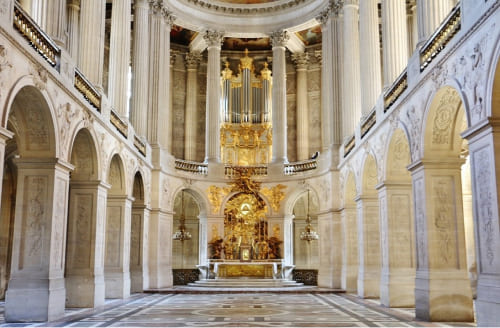
The Gate of Honor (Grille d’Honneur) is the principal entrance to the palace complex and the palace itself. On its north and south sides, respectively, are the sculpture groups, one by Gaspard Marcy known as “Victory over the Empire” and other by Francois Girardon known as “Victory over Spain”.
Beyond the Gates of Honor lies the Court of Honor (Cour d’Honneur), which is positioned between Place d’Armes and the Royal Courtyard from where you can reach the wings of ministers, the entrances to the magnificent palace, and the entry to the enormous gardens. The Royal Court (Cour Royale), which may only be accessed with a special key, greets guests behind the Court of Honor’s Royal Gate.
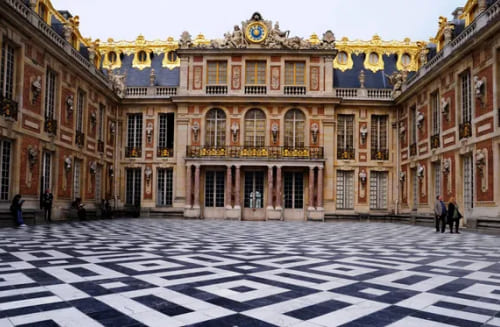
Louis XIV’s Rooms in Versailles were the private chambers of King Louis XIV within the Palace of Versailles. These opulent spaces included his bedchamber, the Grand Cabinet, and the Council Chamber. Lavishly decorated, they showcased the grandeur befitting the Sun King. Today, visitors can explore these rooms and witness the splendor of one of history’s most influential monarchs.
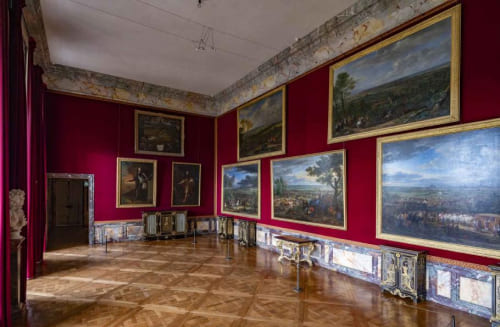
A royal mansion, historical museum, and Republican palace all rolled into one as the Palace of Versailles. Over 6 million tourists from across the world visit Versailles annually, and they need to be made aware of the site’s intricacy. The Palace of Versailles in collaboration with Google unveils Palace History Gallery housed in a former princely apartment, it tells the story of Versailles: from Louis XIII’s hunting lodge to what is now the palace museum. The eleven rooms gallery consisting of paintings, reproductions of old prints, and models depict the complete history of the Palace. Stunning 3D reconstructions and physical model replicas of the Versailles treasures are displayed during the tour.
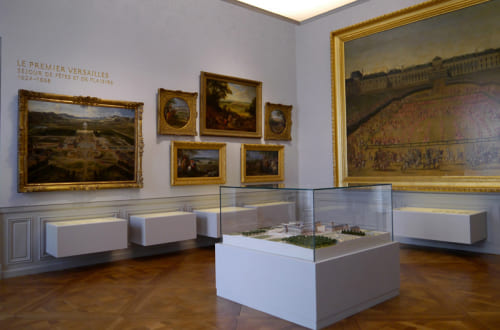
Napoleon Bonaparte, who came to power following the French Revolution, is honored in the 13 Empire chambers. The Empire Rooms were King Louis-attempt Philippe to win over Bonapartist sentiment and the backing of former Empire members. He had, after all, ascended to the throne with Napoleon I. Every year and every campaign of the young artillery commander who trusted in his “lucky star” are depicted in the chambers.
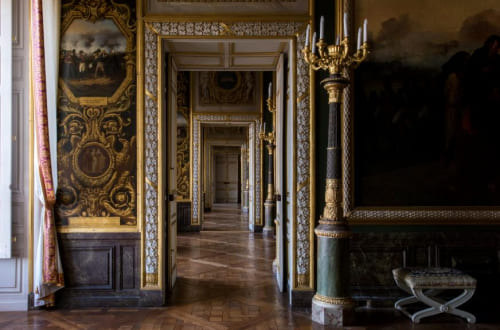
It was not until the 19th century that the 120 m long battle gallery in the south wing was laid out by Frédéric Nepveu on behalf of Louis Philippe, King of the Citizens. He made Versailles a “museum for everyone” – and had the most important works for the glory of France exhibited here: paintings and busts of famous military leaders. David’s painting “The Coronation of Napoleon and the Empress Joséphine” gave the Coronation Hall its name. With 35 paintings and 82 busts illustrating almost fifteen centuries of French military success from Clovis to Napoleon. This is the largest room in the palace, occupying almost the entire ground floor of the south wing.
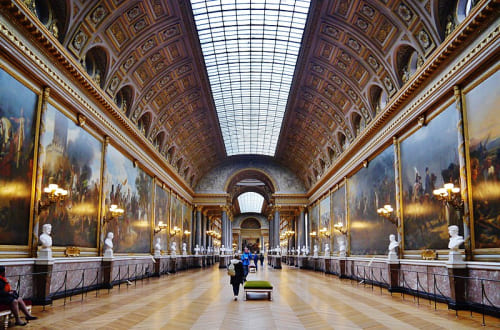
The Hall of Mirrors is considered by some to be Louis XIV‘s most notable contribution to Versailles. It is undoubtedly the most well-known chamber in the Château of Versailles and has 357 mirrors that reflect the room’s ornate gilded walls and brilliant crystal chandeliers. The Hall of Mirrors’ ceiling frescoes, which portray Louis XIV’s history, contribute to the space’s magnificent splendor. The main feature of the hall is the seventeen mirrored arches which reflect the seventeen arched windows that look out over the equally beautiful gardens of Versailles. This magnificent hall is 73 meters long, 10.5 meters wide, and 12.3 meters high.
King Louis XIV’s private apartment underwent several aesthetic changes throughout his rule, depending upon his preferences. Originally, the room’s door opened into the hall of mirrors but the doors were sealed. King’s Chamber was the most used throughout the day. King’s waking up, going to bed, dining in privately, and even meeting guests were done there. It is one of the symbolic and historical attractions of the Palace of Versailles.
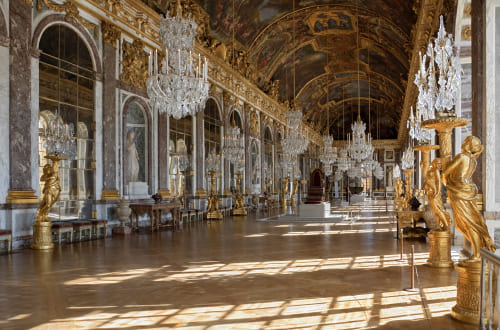
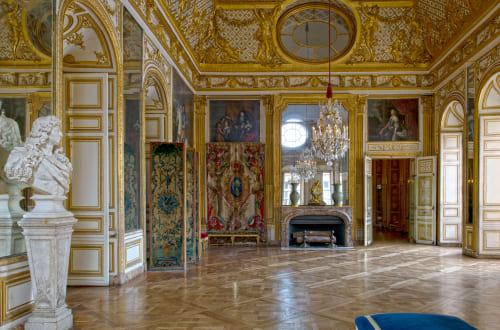
The Palace of Versailles also reopens the Dauphin’s apartment, with three main rooms (bedroom, large study, library), which have been fully restored and are among the richest and best preserved princely apartments in the world. Louis XV’s daughter’s apartment is symmetrical to Dauphin’d apartment. Closed to the public for nearly ten years, the apartment has regained much of its original decoration, masterpieces of rocaille style. It is said that King Louis XV’s six daughters lived here from 1752 and among them, only two remained till the Frech revolution, since they never married and spent their old age here.
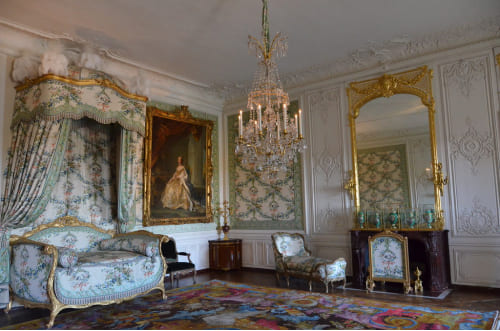
What’s Inside Versailles Palace? The most impressive part of the Palace of Versailles is often considered to be the Hall of Mirrors (Galerie des Glaces). This grand gallery features 17 mirrored arches reflecting 17 arcaded windows that overlook the palace’s gardens. The hall is renowned for its opulent decoration, including magnificent chandeliers, ceiling paintings, and intricate gilding.
Yes, Versailles does have secret rooms, passages, and chambers. These hidden spaces were often used by the royal family and courtiers for private meetings, escape routes, and other clandestine purposes. One example is the Queen’s Secret Cabinet, a small room hidden behind a mirror in Marie Antoinette’s chambers.
The Venus Room (Salon de Venus) in Versailles features a ceiling painting depicting the mythological scene of Venus, the goddess of love, surrounded by cherubs. This exquisite artwork is attributed to the French painter François Boucher and is one of the many stunning decorative elements found throughout the palace.
The King’s Bedroom (Chambre du Roi) in Versailles is located in the King’s State Apartments (Grands Appartements du Roi) on the first floor of the palace’s main building. This lavishly decorated room served as the private sleeping quarters of the king and was one of the most important and private spaces in the palace.
Some of the must-see attractions at the Palace of Versailles include the Hall of Mirrors, the King’s State Apartments, the Queen’s State Apartments, the Royal Chapel, the Gardens of Versailles, and the Grand Trianon. Additionally, visitors should not miss the opportunity to explore the Petit Trianon and the Queen’s Hamlet, which offer insights into the private lives of the royal family.
VERSAILLES PLACES
From the royal court, roam freely on the various circuits of the château, then traverse the small gardens and woods, and head to…
VERSAILLES PLACES
Discover the stunning private residence of Queen Marie-Antoinette, surrounded by lovely grounds and with her own…
VERSAILLES PLACES
The palace garden was the most important thing for King Louis XIV and is world-famous today. The gardens feature 14 fountains…
